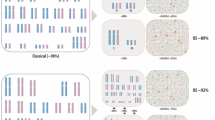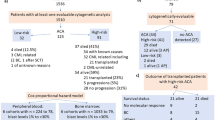Abstract
Chromosome gain is frequent in acute myeloid leukemia (AML) and is counted alongside structural abnormalities when determining karyotype complexity. However, there are few studies investigating the cytogenetic profile and outcome of patients with a hyperdiploid karyotype (49–65 chromosomes, HK). We identified 221 (14%) patients with HK out of 1563 patients with three or more chromosomal abnormalities. HK was not associated with sex, white cell count and secondary disease status, but was more prevalent among children (22% vs 13%). The pattern of chromosomal gain and loss was non-random and chromosomes 8, 13 and 21 were the most frequently gained. Three distinct subgroups (numerical, structural and adverse) were identified with differential outcome: 5-year cumulative incidence of relapse of 52%, 68% and 76%, respectively (P=0.008). Patients in the adverse subgroup had poorer survival compared with patients with only numerical abnormalities (adjusted hazard ratio: 2.01 (95% confidence interval: 1.43–2.83), P=0.0002). This outcome heterogeneity was similar among children and adults. In conclusion, AML patients with a HK should not automatically be assigned to the adverse cytogenetic risk group on the basis of complexity. Instead they should be assessed for the presence of specific chromosomal abnormalities, which are known to harbour an adverse effect.
This is a preview of subscription content, access via your institution
Access options
Subscribe to this journal
Receive 12 print issues and online access
$259.00 per year
only $21.58 per issue
Buy this article
- Purchase on Springer Link
- Instant access to full article PDF
Prices may be subject to local taxes which are calculated during checkout





Similar content being viewed by others
References
Grimwade D, Hills RK, Moorman AV, Walker H, Chatters S, Goldstone AH et al. Refinement of cytogenetic classification in acute myeloid leukemia: determination of prognostic significance of rare recurring chromosomal abnormalities among 5876 younger adult patients treated in the United Kingdom Medical Research Council trials. Blood 2010; 116: 354–365.
Schoch C, Kern W, Kohlmann A, Hiddemann W, Schnittger S, Haferlach T . Acute myeloid leukemia with a complex aberrant karyotype is a distinct biological entity characterized by genomic imbalances and a specific gene expression profile. Genes Chromosomes Cancer 2005; 43: 227–238.
Dohner H, Estey EH, Amadori S, Appelbaum FR, Buchner T, Burnett AK et al. Diagnosis and management of acute myeloid leukemia in adults: recommendations from an international expert panel, on behalf of the European LeukemiaNet. Blood 2010; 115: 453–474.
Mrozek K, Marcucci G, Nicolet D, Maharry KS, Becker H, Whitman SP et al. Prognostic significance of the European leukemiaNet standardized system for reporting cytogenetic and molecular alterations in adults with acute myeloid leukemia. J Clin Oncol 2012; 30: 4515–4523.
Grimwade D, Walker H, Oliver F, Wheatley K, Harrison C, Harrison G et al. The importance of diagnostic cytogenetics on outcome in AML: analysis of 1,612 patients entered into the MRC AML 10 trial. The Medical Research Council Adult and Children’s Leukaemia Working Parties. Blood 1998; 92: 2322–2333.
Byrd JC, Mrozek K, Dodge RK, Carroll AJ, Edwards CG, Arthur DC et al. Pretreatment cytogenetic abnormalities are predictive of induction success, cumulative incidence of relapse, and overall survival in adult patients with de novo acute myeloid leukemia: results from Cancer and Leukemia Group B (CALGB 8461). Blood 2002; 100: 4325–4336.
Breems DA, Van Putten WL, De Greef GE, Van Zelderen-Bhola SL, Gerssen-Schoorl KB, Mellink CH et al. Monosomal karyotype in acute myeloid leukemia: a better indicator of poor prognosis than a complex karyotype. J Clin Oncol 2008; 26: 4791–4797.
Patnaik MM, Hanson CA, Hodnefield JM, Knudson R, Van Dyke DL, Tefferi A . Monosomal karyotype in myelodysplastic syndromes, with or without monosomy 7 or 5, is prognostically worse than an otherwise complex karyotype. Leukemia Feb 2011; 25: 266–270.
Haferlach C, Alpermann T, Schnittger S, Kern W, Chromik J, Schmid C et al. Prognostic value of "monosomal karyotype" in comparison to "complex aberrant karyotype" in acute myeloid leukemia: study on 824 cases with aberrant karyotype. Blood 2012; 119: 2122–2125.
Mitelman Database of Chromosome Aberrations and Gene Fusions in Cancer (2013) In: Mitelman F, Johansson B and Mertens F (eds), http://cgap.nci.nih.gov/Chromosomes/Mitelman.
Luquet I, Lai JL, Barin C, Baranger L, Bilhou-Nabera C, Lippert E et al. Hyperdiploid karyotypes in acute myeloid leukemia define a novel entity: a study of 38 patients from the Groupe Francophone de Cytogenetique Hematologique (GFCH). Leukemia 2008; 22: 132–137.
Harrison CJ, Hills RK, Moorman AV, Grimwade DJ, Hann I, Webb DK et al. Cytogenetics of childhood acute myeloid leukemia: United Kingdom Medical Research Council Treatment trials AML 10 and 12. J Clin Oncol 2010; 28: 2674–2681.
Damgaard Sandahl J, Abrahamsson J, Heldrup J, Jahnukainen K, Jonsson OG, Lausen B et al. Hyperdiploidy in childhood AML associated with low age and AML-M7. A NOPHO-AML study and literature review [abstract]. Blood 2011; 118: 3529.
Bowen D, Groves MJ, Burnett AK, Patel Y, Allen C, Green C et al. TP53 gene mutation is frequent in patients with acute myeloid leukemia and complex karyotype, and is associated with very poor prognosis. Leukemia 2009; 23: 203–206.
Grossmann V, Schnittger S, Kohlmann A, Eder C, Roller A, Dicker F et al. A novel hierarchical prognostic model of AML solely based on molecular mutations. Blood 2012; 120: 2963–2972.
Rucker FG, Schlenk RF, Bullinger L, Kayser S, Teleanu V, Kett H et al. TP53 alterations in acute myeloid leukemia with complex karyotype correlate with specific copy number alterations, monosomal karyotype, and dismal outcome. Blood 2012; 119: 2114–2121.
von Neuhoff C, Reinhardt D, Sander A, Zimmermann M, Bradtke J, Betts DR et al. Prognostic impact of specific chromosomal aberrations in a large group of pediatric patients with acute myeloid leukemia treated uniformly according to trial AML-BFM 98. J Clin Oncol 2010; 28: 2682–2689.
Dicker F, Haferlach C, Kern W, Haferlach T, Schnittger S . Trisomy 13 is strongly associated with AML1/RUNX1 mutations and increased FLT3 expression in acute myeloid leukemia. Blood 2007; 110: 1308–1316.
Schoch C, Kohlmann A, Dugas M, Kern W, Schnittger S, Haferlach T . Impact of trisomy 8 on expression of genes located on chromosome 8 in different AML subgroups. Genes, chromosomes & cancer 2006; 45: 1164–1168.
Paulsson K, Johansson B . High hyperdiploid childhood acute lymphoblastic leukemia. Genes Chromosomes Cancer 2009; 48: 637–660.
Acknowledgements
We thank all the clinicians participating in the MRC/National Cancer Research Institute trials and members of laboratories of the United Kingdom Cancer Cytogenetics Group (UKCCG) and cytogenetic laboratories from Denmark and New Zealand. DG, CJH and AVM are grateful to Leukaemia and Lymphoma Research, UK, for funding; DG, RKH and AKB also acknowledge support from the National Institute for Health Research and the European LeukemiaNet. The MRC trials databases have been supported by Kay Kendall Leukaemia Fund and Leukaemia and Lymphoma Research.
Author contributions
LC, RKH, DG and AVM designed the study and wrote the manuscript; RKH and LC performed statistical analyses; AVM and CJH classified the cytogenetic abnormalities and managed the cytogenetics database; AKB was the lead participant in the MRC AML trials; and all authors approved the final version of the manuscript.
Author information
Authors and Affiliations
Corresponding author
Ethics declarations
Competing interests
The authors declare no conflict of interest.
Additional information
Supplementary Information accompanies this paper on the Leukemia website
Supplementary information
Rights and permissions
About this article
Cite this article
Chilton, L., Hills, R., Harrison, C. et al. Hyperdiploidy with 49–65 chromosomes represents a heterogeneous cytogenetic subgroup of acute myeloid leukemia with differential outcome. Leukemia 28, 321–328 (2014). https://doi.org/10.1038/leu.2013.198
Received:
Revised:
Accepted:
Published:
Issue Date:
DOI: https://doi.org/10.1038/leu.2013.198
Keywords
This article is cited by
-
A new adult AML case with an extremely complex karyotype, remission and relapse combined with high hyperdiploidy of a normal chromosome set in secondary AML
BMC Hematology (2018)
-
The prognostic significance of trisomy 4 in acute myeloid leukaemia is dependent on age and additional abnormalities
Leukemia (2016)
-
Karyotype complexity and prognosis in acute myeloid leukemia
Blood Cancer Journal (2016)



